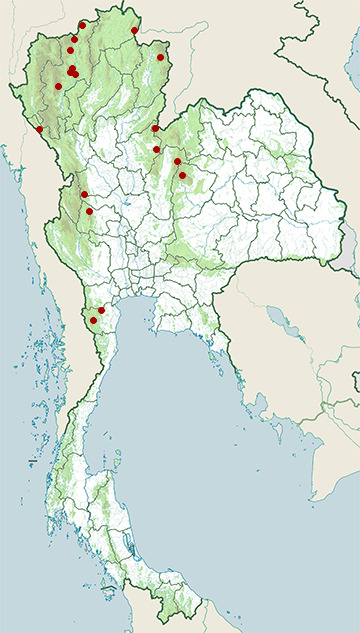Species of Thailand
Grey-chinned minivet
Pericrocotus solaris
Edward Blyth, 1846
In Thai: นกพญาไฟคอเทา
The grey-chinned minivet (Pericrocotus solaris) is a species of bird in the family Campephagidae. It is found from the Himalayas to China, Taiwan and Southeast Asia. Its natural habitat is forests about 1000 - 2000 m in elevation. The International Union for Conservation of Nature (IUCN) has assessed it as a least-concern species.
Taxonomy
This species was described from Darjeeling by Edward Blyth in 1846. The IOC World Bird List recognises eight subspecies: Pericrocotus solaris solaris found in the Himalayas and northern and western Myanmar; P. s. rubrolimbatus in eastern Myanmar and northern Thailand; P. s. montpellieri in southern China; P. s. griseogularis in southeastern China, Taiwan, northeastern Laos and northern Vietnam; P. s. deignani in southern Laos and central Vietnam; P. s. nassovicus in eastern Thailand and southern Cambodia; P. s. montanus in western Malaysia and Sumatra; and P. s. cinereigula in Borneo. The Handbook of the Birds of the World considers that montanus and cinereigula form a separate species.
Description
The grey-chinned minivet is 17 - 19 cm long and weighs 11 - 17 g. It is sexually dimorphic. The adult male has a dark grey head and mantle, a pale grey chin, an orange-yellow throat and blackish wings. The underparts, lower back and tips of the greater coverts are orange. In the female, these parts are bright yellow instead. The eyes, beak and legs are black. The immature bird is similar to the female but has yellow-olive bars on its back.
Distribution and habitat
This species ranges from the eastern foothills of the Himalayas through northeastern India, southern China, mainland Southeast Asia to Sumatra and Borneo. Its habitat is montane forest about 1000 - 2000 m in elevation. In Taiwan, it has been recorded down to 150 m. It lives in the canopy of broadleaf forest and also coniferous forest, elfin forest, secondary forest, forest edges and gardens with trees. It is thought that all 12 of the minivet species adaptively radiated in mainland Asia and later dispersed to the Indonesian archipelago.
Behaviour
When not breeding, this minivet forms small parties with fewer than 15 individuals and also large flocks of dozens of birds; it sometimes joins mixed-species foraging flocks. It forages for invertebrates in the canopy, sometimes descending to tree ferns or sallying in the air. It gives a twittering call while feeding, and contact calls include a high-pitched and a .
Breeding has been recorded from February to April and has been inferred to occur in January. The male has been observed walking towards the female while holding a flower in its beak; the male swung its head, touched the female's beak and dropped the flower, and then they mated.
The nest, constructed by both sexes, is built on a branch or fork of a tree. It is a steep cup made of bryophytes and covered with felt externally. Lichens are added to camouflage the nest, and the female shapes the nest by pushing against the rim with its breast. The eggs have not been described. The male and female raise the brood together, and subadults have been seen helping them. Moulting occurs from June to October.
Status
This species has a large range and stable population, so the IUCN has assessed it as a least-concern species.
This article uses material from Wikipedia released under the Creative Commons Attribution-Share-Alike Licence 3.0. Eventual photos shown in this page may or may not be from Wikipedia, please see the license details for photos in photo by-lines.
Category / Seasonal Status
BCST Category: Recorded in an apparently wild state within the last 50 years
BCST Seasonal status: Resident or presumed resident
Scientific classification
- Kingdom
- Animalia
- Phylum
- Chordata
- Class
- Aves
- Order
- Passeriformes
- Family
- Campephagidae
- Genus
- Pericrocotus
- Species
- Pericrocotus solaris
Common names
- Thai: นกพญาไฟคอเทา
Conservation status

Least Concern (IUCN 3.1)
Photos

Range Map

- Chiang Dao Wildlife Sanctuary
- Doi Inthanon National Park
- Doi Pha Hom Pok National Park
- Doi Phu Kha National Park
- Doi Suthep - Pui National Park
- Huai Kha Khaeng Wildlife Sanctuary
- Kaeng Krachan National Park
- Mae Moei National Park
- Mae Rim District, Chiang Mai
- Mae Wong National Park
- Mueang Chiang Mai District, Chiang Mai
- Nam Nao National Park
- Nong Ya Plong District, Phetchaburi
- Pha Daeng National Park
- Phu Chi Fa Forest Park
- Phu Hin Rong Kla National Park
- Phu Khiao Wildlife Sanctuary
- Phu Suan Sai National Park